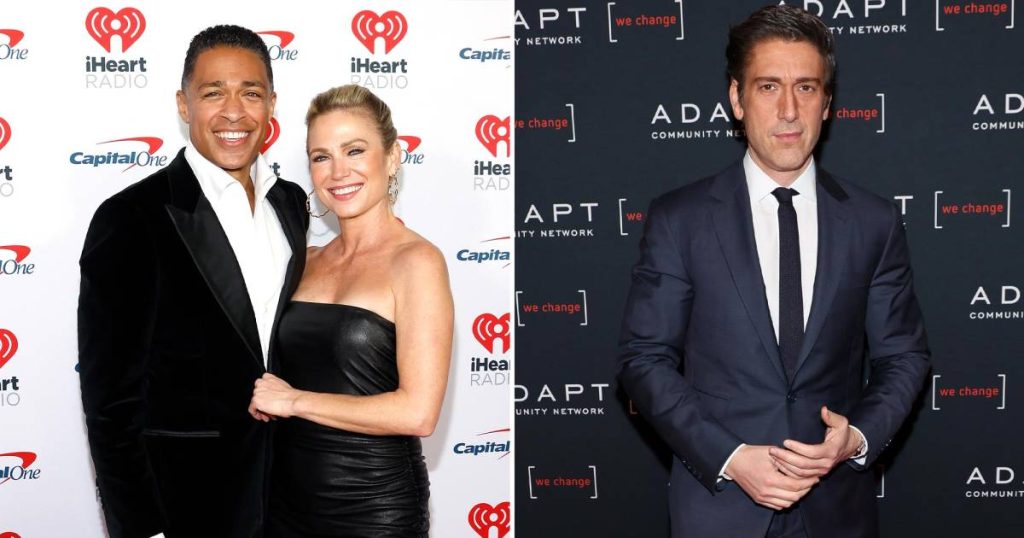The recent controversy surrounding David Muir’s use of a clothespin on his jacket while reporting on the Los Angeles wildfires has ignited a debate about the appropriateness of focusing on appearances during times of crisis. Muir, an anchor for ABC News, was criticized for seemingly prioritizing his attire while covering a devastating natural disaster that resulted in loss of life and property. This incident sparked a wave of online backlash, with many accusing Muir of insensitivity and vanity. However, former ABC colleagues T.J. Holmes and Amy Robach have come to Muir’s defense, offering insights into the behind-the-scenes realities of live television reporting and challenging the narrative surrounding the clothespin incident.
Holmes and Robach, now hosts of the podcast “Does This Make Me Look Fat?”, argue that viewers lack the full context of the situation. They suggest that Muir may have been unaware of the clothespin’s presence, as anchors are often surrounded by producers and wardrobe personnel making adjustments while they prepare for their reports. In the midst of gathering information, reviewing notes, and managing the technical aspects of a live broadcast, an anchor’s attention might be diverted, making them oblivious to minor wardrobe adjustments. Holmes emphasizes the demanding nature of Muir’s job, highlighting his dedication and hard work. While acknowledging the negative optics of the clothespin, he argues that the online criticism directed at Muir is excessive and unwarranted.
Further elaborating on the complexities of on-air appearances, Holmes acknowledges the inherent tension between maintaining a professional image and appearing insensitive to the gravity of a situation. He argues that it’s unreasonable to expect journalists to completely disregard their appearance, especially when presenting to a national audience. However, he concedes that the degree to which an anchor focuses on their looks can become problematic, especially when covering a tragedy. The perception of vanity, particularly in the face of suffering, can understandably provoke anger and resentment among viewers. The incident underscores the delicate balance journalists must strike between presenting themselves professionally and demonstrating empathy for the individuals and communities affected by the events they are reporting.
Robach, drawing on her own experience as a field reporter, explains that she consciously avoids appearing overly “glamorous” when covering tragedies. She describes the stark contrast between the polished look expected in a studio setting and the more practical approach required in the field. Recognizing the sensitivities involved in reporting on disaster zones, she opts for simplicity in her hair and makeup, aiming to convey respect for the gravity of the situation. This conscious decision reflects a broader understanding of the optics involved in reporting on sensitive topics and the importance of aligning one’s appearance with the tone of the coverage.
Robach also vehemently defends Muir against the criticism he received, asserting that it’s both unfair and inappropriate. She attributes the backlash in part to a lack of understanding about the pressures faced by television personalities, whose appearance is constantly scrutinized. This constant evaluation can lead to a heightened awareness of one’s image, a sensitivity that viewers may misinterpret as vanity. Robach argues that judging Muir based solely on this isolated incident fails to acknowledge his overall professionalism and commitment to journalism.
In conclusion, the clothespin incident involving David Muir has sparked a broader conversation about the role of appearances in journalism, especially when reporting on sensitive topics like natural disasters. While the public’s concern about perceived insensitivity is understandable, the perspectives offered by Holmes and Robach provide valuable context. They highlight the often unseen demands of live television reporting and the pressures faced by anchors to maintain a professional image. While the optics of the clothespin incident were undoubtedly unfortunate, the incident serves as a reminder of the complexities surrounding on-air presentation and the challenges journalists face in balancing professionalism with empathy. It also underscores the importance of considering the full context of a situation before rushing to judgment, especially in the fast-paced and often unforgiving world of social media.

